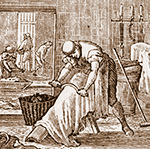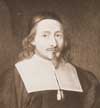Record of the Descendants of Vincent Meigs: Who Came from Dorsetchire By Henry Benjamin Meigs, "John Meigs"
Meggs. John, Weymouth. He m. a sister of William Fry, who beq. to her son John in 1643. Ch. John b. 29 (12) 1641-2. (P. of M. p. 310.)
Extract from the History of the Judges of King Charles I: Whalley, Goffe and Dixicell. By Ezra Stiles, Pres'dt of Yale College.1794. folio 51.
The report to Governor Endicott, Boston, Mass., dated May 29th, 1661, by Thomas Kellon and Thomas Kirk, who were sent by him under instructions from Charles II, to Connecticut to find and arrest these three judges, "Regicides."
They reported that whilst at Guilford, Connecticut,
To their certain knowledge, one John Meggs, was sent a horse-back before us, and by his speedy going, so early before day, he gave them information, so that they escaped us.
So important has this episode in history appeared in our times that at least two novels, "The Regicides," and "Judges Cave," have been written within the past two years, in both of which John Meggs figures as a prominent character.
The following will serve to illustrate the tendency of John Meigs to patronize the Courts of Justice.
In 1647, while living in New Haven, he had a law suit over the making of some shoes, his trade being that of a tanner and currier, also a dealer in shoes and doubtless a shoe maker. John sued one Gregory, of the same trade for damage done him from the unworkmanlike manner in which several dozen pairs of shoes had been made. John furnishing the leather and thread and carrying the shoes "ready cut out " to Gregory, agreeing to pay him one shilling per pair. Gregory upon testimony was convinced he had not done his part, but said, "Meigs encouraged slighting the work," while Meigs being called to propound his damage, instanced five particulars;
1st, damage to his name;
2nd, damage to Mr. Evance to whom he engaged to supply with goods;
3rd, damage in having his wares turned back on his hand;
4th, hinderance in his trade, people leaving on account of his trouble, shunned his wares;
5th, money paid several men for satisfaction.
The Court referred the matter to a Committee of shoe makers and tanners, who found both men " faulty " and ordered Meigs to pay a ten pound fine and give satisfaction to every person damaged, and Gregory to pay a fine of five s
Copy of a Proceedings of a Regular Court held in
Guilford, Dec. 4, 1657.
John Meigs being called for on complaint that he came with his cart from Hamonasset late in the night on the Lord's Day, making a noise as he came, to the ofrense of many who heard it.
Then appeared and answered that he was mistaken in the time of day. Thinking that he had time enough for the journey. But being somewhat more laden than he apprehended, the cattle came more slowly than usual, and so cast him behind, it proving to be more late of the day than he had thought. But he professed to be sorry for his mistake, and the offense justly given thereby, promising to be more careful for the time to come.
The Court considered the promisees did see cause (seeing that the matter seemed to be done through surprisel and not willingly) to pass it over with a reproof for this first time, on his giving a public acknowledgment of his evil in so neglecting to remember the Sabbath, on the next lecture or first day, with all the aggravating circumstances in it.
(Signed) William Leete.
October 31, 1657, we find the case of Meigs vs. Chapman aud Parker, "in an action for tresspass." The case is interesting, and the spelling sufficiently so to entitle it to a place here. John Meigs claimed that after he had
fenced his land at Athamonossook, were such an orderly fence, as was sufficient to keep out great cattell; yet the Defendants' hoggs came into his field & destroyed his corne.
John claimed damages, and a witness whom he introduced testified to bringing out of the corn fifteen hogs belonging to Parker at one time, and to having seen,
sundry other times the Defendants' hoggs in Corne doing spoile.
The defendants put in a plea that the fence was insufficient and as they—Chapman and Parker—were strangers who lived in Saybrook, whence the "hoggs" must have strayed, the Court despatched viewers to examine the fence. The viewers reported to the Court that the fence was not " sufficient to keep out great Cattell." Thereupon, the Court decided that it could not relieve the plaintiff;
but desired the defendants would consider the great losse the plaintiff sustained by their hoggs it that, therefore, in a neighborly way, they should considier to afford some supply, as themselves would desire in a like case. That amity & good agreement might be the better maintained betwixt the persons & Towns of Seabrooke and Guilford as formerly.
John Meggs, Senior, this 11th May, 1668.
Know All Men by these Presents: That I, John Meggs, Senior, of the new plantation of Hammonnasset. . .I do hereby freely fully give, grant, will and bequeath the said all unto myne only and beloved son, John Meggs, Junior. I say myne only son and heir, to be unto him and the heirs of his body forever to their owne use and I dispose to them, their administrators or assigns upon the decesse of me the aforesaid John Meggs, Sen., and do by these presents warrant my act and deed against whatsoever will, documents, deed or deeds divers contrary to what is here expressed and truly intended. That is to say what is expressed is what we shall clayme, and in case he died without heir or hope of heir this, my act and deede to be voide and to return unto myne dispose and to the true and faithful performance hereof.
I have set my hand and seal the seventh of the firstt month of the year of our Lord one thousand six hundred and sixty-five or six.
John Meggs.
Read, signed and sealed and delivered as my act and deede in the prssence of
Samuel Stowe.
Joseph Wilcoxson.
Elbazar Isbell.
August ye 28th, 1671.
The Last Will and Testament of John Meiggs, Senr., Deceased.
I, John Meiggs, Senr., being of perfict Memory, though Sick of bodie, Do here Set down my last Will and Testament for the more quiett Settling of that Estate God hath given me, after I am dead.
Impt: I Give unto My Son John, besids my farme Houses, Barne, upland and meadow with all yt to me blongs at Hamonastit now called East and in Guilford plantation which I have formerly made over to him by waie of Deed and past as my last lagacye, all my wrightings, Books and manuscripts. also my book of Marters Rolls, History of ye World, Bacons, Thomas Bacons, also Simpson's English Greek Lexicon, and Thams Dixonarye.
Also to my Daughter Mary Stevens, I give fivety pounds in one Mare and part in Cattle and other part in Houshold Stuff all at ye prizes I have vallued them as will appear in a Schedule hereunto anexed this fivety pounds, it is my will to be made Sure to my Daughteer Mary, & after her Decease, to her Son Nathaniel or if he dye, to the next Brother, Suckseesively; if her Hssband Take This Estate into his hands, my will is that he Secure so much Lands to-wit: fifty pounds worth for The end aforesd.
Also to my Daughter Concurance Crane, I Give my new Dwelling House or houses, Barn, home lott with ye pasture thereunto adjoining as also my planting field lott, four acres and half more or less, as also my Last Divition, not laid out though agreed to be on ye Long hill; as also my meadow at the Bridge at Hammonaset River, both The Lott I had from The Town and ye Lott That was Goodman Walmen adjoining. As also my Lott of meadow next my Neck Lott, the pomt of Meadow. Also I Give her my Land on ye the great Hamak, lymg next to Andrew Wards, all which I and and Houses I So give to my Daughter Crane, as to Remaine to her during her naturall Life, and after her Death to her Son John and his Children, not to be allienated, if he die Childless, to Returne to his sister Elizabeth, or if She dye Childless, then to Concurance his Sister and not to be Sold or alienated from them.
To my daughter Tryall Ward, I Give my House and orchard and my grass plott at Guilford as also my Meadow at the Salt Roles, Eight acres more or less, lying next adjoining William Sewards, as also yt island of meadow, lying at the harbour or Mill Creek Mouth. That island of Meadow, lying at the Harbours or Mill Creeks mouth, yt formerly Serjent Jones's and the half of yt meadowing adjoining to it, her husband having bought The other half allready of Son John. As also I give unto her That five acres of upland more or less That lyes on ye South Side of ye sd meadow butting upon it, as also I give her my last Division of meadow, lying next Richard Hubbels and ye North Side of the Creek against part of that meadow, her Husband bought of Jonathan Dunin, alias Singeltarye. Lastly I give her also my Neck Lott upland & Meadow as it is bounded and Recorded, and all this to Remaine to her During her natural Life and not to be altered or changed and after her Death to be her Sun Andrews, or if he die and have no Children then to Returne to his next Brother John and his seed.
Memorandum. To my Nephew Mary Hubble, as her Mother's portion, She being dead, I give Thirty pounds to be paid out of my movabells Estate, part in Cattle and part in House-holdsstuff with this provisoo, She being obedient to her Grand-Mother, and hving with her to the day of her, to-wit: her Grandmother's Death.
Lastly none of these Legacys are to be Demanded as due during the Life of my wife unto whom I give all my a Estate Except my foresdfarme at Hamonasitt aforemention to her ye with all ye Rest of my Estate not here mentioned, whom I make my Sole Executrixs of all my Estate for her owne use as aforesd: but not to give, Sell or alter the property of the Estate
Witness, John Meiggs.
Josoah Hull,
Jonas Westover,
Joseph Willcokson
June ye 4th, 1672, proved




